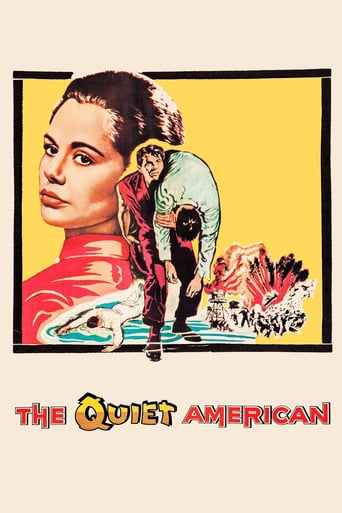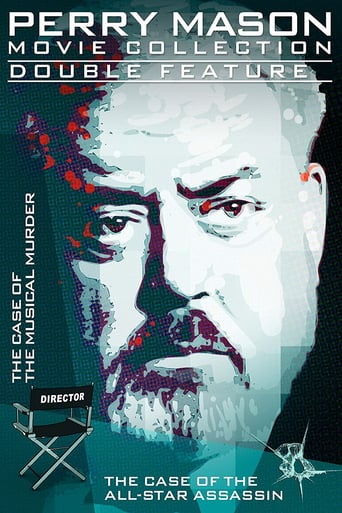Mark Turner
While I'm familiar with the name Graham Greene I've never read one of his books. Of his works the only one I've ever seen was THE THIRD MAN for which he wrote the screenplay based on his own novella. So when I took to watching this movie I was interested to see what I'd make of it.The story is more romance than spy story though it has elements of both. It takes place in the mid-fifties in Vietnam, a country poised on the brink of war and being tugged at both ends by different political factions. The tale is told through the eyes of British foreign correspondent Thomas Fowler (Michael Redgrave), a world weary reporter who's seen it all and has little hope for peaceful solutions.Fowler lives in an apartment with his companion Phuong (Giorgia Moll), a young Vietnamese girl who hopes to accompany him when he returns home. Fowler has told her that when he does so he will divorce his wife and the two of them will live together but the reality is that his wife, a devout Catholic, is unwilling to give him a divorce.Into their lives enters Alden Pyle (Audie Murphy). Pyle is unnamed in the movie but named in the book. Pyle supposedly works for an import/export business in town but in reality is an agent of the CIA. Dedicated to his job and believing that there is a solution to the problems in the country, he befriends first Fowler to learn more and then becomes enamored with Phuong. While Fowler has no real intention of taking Phuong with him, he finds himself insanely jealous of the attention Pyle shows her.Parts of this are interesting to watch as the two men discuss their intentions and Phuong not necessarily as a human being but as something they can barter over. Both have different beliefs about her, Fowler that she will just go along with the political climate offered here and Pyle that she can become an American with a sympathetic lifestyle. Her attitude towards it all is simple, she just wants to leave the country and go somewhere that has more opportunity. Eventually the romantic triangle must find a solution.Just how far Fowler is willing to go to put an end to his potential rival becomes a big part of the third act of the film. Midway through the pair find themselves stuck in a watchtower and have time to discuss their differing political views. Ever the cynic Fowler finds Pyle to be naïve rather than informed. None of it bodes well for Pyle.The film was supposed to be an anti-war piece but was twisted during production. Much of that revolved around the fact that this was during the blacklist period of Hollywood and the fear was it would be construed as a pro-Communist film. One thing it did so was predict the difficulties that would take place in Vietnam in years to follow. While a critical success it wasn't a huge hit at the box office.I think part of the reason for this was the structure of the film. It plays like a book and at times can be overly wordy. With little action to be found the movie crawls at a snail's pace while we wait to see what happens. Murphy was a star by this time, a decorated WWII hero who was known to play in westerns. This was a change of pace and it may have confused movie goers at the time. Still it makes for an interesting look at a topic rarely covered this way when it comes to Vietnam.Twilight Time provides the standard great looking picture with this release but few extras. All you will find here are an isolated music track with some effects and the theatrical trailer. But if interested make sure you pick one up before they're gone as the standard 3,000 copies have been made for release.
sddavis63
Personally, I thought this movie never really found its direction. One of the advantages of a novel (this is based on one by Graham Greene) is that it can go in many different directions successfully and work very well because the written word allows for a much fuller depiction of what's happening. If you translate the novel into a movie, though, you're dealing with a more limited medium and it's a lot harder to make multiple story lines work. So - what was this? Part Cold War thriller, part murder mystery, part romance, with various other things thrown in, mixed together and ending up as mush.There were parts of this that I enjoyed. Generally, I thought that Peter Redgrave as Fowler (a middle aged, jaded British journalist) and Audie Murphy as "The American" put on pretty decent performances, I appreciated the look (somewhat limited but still present) at Vietnamese culture, and I also appreciated the portrayal of the very early years of the Vietnam War, when it was still the French dealing with a Communist insurgency in what was then an integral part of their Empire. It was an interesting look at that aspect of the Cold War. Not really anti-Communist, as one might expect from the era, but somewhat anti-everything. In that sense, the movie took on Fowler's jaded personality. Starting with the American's murder, the story revolves around the search for the killer and I didn't find that part to be particularly interesting. Unfortunately, that's the bulk of the movie. Woefully underused and under-appreciated, I thought, was Giorgia Moll as Phuong, the young Vietnamese girl who becomes a love interest to both Fowler and the American. One wonders why an Italian born actress was cast as a Vietnamese (not a single Asian actress was around in 1958?) but more disappointing was that she had little to do except sip her ever-present milkshakes.Frankly, I found most of this dreadfully boring. 3/10
William J. Fickling
I just saw this film on Turner Classic Movies. When it was over I was reminded of Hemingway's comment when he was asked his opinion of the film version of "The Snows of Kilimanjaro": "it was okay except for one difference; in my story the protagonist dies, and in the film he lives." This film is as much a distortion of Greene as the other film was of Hemingway; in Greene's novel the title character was intended to be a villain, but in this film he is a hero.It is not a spoiler to tell you that the title character dies, because the film begins with his death and tells what leads up to it in flashback. In Greene's novel, the seemingly naive, idealistic American who is in (then) French Indochina for vaguely idealistic operative is in fact a sinister undercover CIA operative in cahoots with an unscrupulous general. Together with the general, he plans and executes bombings in public places that result in the deaths of dozens of innocent people, then leaves evidence making it appear that the Communists carried out the bombing. His purpose is to turn the Vietnamese people against both the French and the Communists, leaving them open to intervention by the US, who will of course put the renegade general in charge. The American is seen as so evil by Fowler, the pathetic English journalist who is his rival in love, that Fowler goes along with a plot to have him killed. The novel is intensely anti-American, as was Greene.By contrast, this film, released in 1958 at the height of the cold war and just after the McCarthy era, could not afford to appear anti-American. The title character is therefore made to appear like a good guy who was indeed hoping for a US-backed "third force" to intervene in Vietnam. He is never identified as a CIA operative, and his complicity in the bombings is revealed as a Communist fabrication intended to dupe the naive Fowler and others. Fowler collaborates in the American's murder because he is a rival in love and not because he is evil. Greene was reportedly outraged at this change and denounced the film. There was some poetic justice: the film was both a commercial and critical failure.There are some merits to the film. It was filmed on location in Saigon, very unusual for the time when most films like this were filmed in the studio. Consequently, we get to see what Saigon was like in a more innocent time, before large scale US intervention. There are several Asian actors and actresses in minor roles, but not in the key role of Phuong, the Vietnamese prostitute with whom both Fowler and the American fall in love. Phuong is played by a Caucasian actress with poor makeup, a continuation of a lamentable Hollywood practice that lasted until the 1960s. There is a superb performance by Michael Redgrave as Fowler. Audie Murphy sleepwalks through his portrayal of the American.This film is an interesting period curiosity that is worth watching, but the 2002 film with Michael Caine and Brendan Frasier is much better and much truer to Greene's novel. That version is highly recommended.
caa821
Audie Murphy was a good-looking man, and the most legitimate of decorated war heroes. However, to describe his acting style -- in any of his films -- as "wooden," in addition to identifying him by name, is unnecessarily redundant.If we were to place some film samples into a time capsule for future generations, to illustrate an example of acting as "wooden," or, say, with a range of "A-to-B" -- Audie's work would be a perfect example (we could add some from Patrick Swayze, as well). But in spite of this and other performances which are less than stellar, this work provides a glimpse of Vietnam and Southeast Asia, presented a decade before the onset of the Vietnam conflict of the 1960's, and is part of the post-war McCarthy era, where our government took paths which history has shown to be less than wise.With this in mind, and viewing this film a half century after it was made, the sense of history it provides is its most powerful attribute.I also could not help but imagine how a film depicting the events in Iraq and the Mideast during the period of the 1990's into the present circumstances, will appear to viewers when it is seen and commented upon, at a site such as this, say, around 2050 or 2060.





